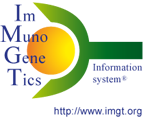Antibodies (or Immunoglobulins)
Antibodies or Immunoglobulins are proteins capable of specific recognition and binding with an antigen. Antibodies carries antigen-binding sites that bind non-covalently with the corresponding antigen epitope. Antibodies are produced in the body by the B lymphocytes at the cell surface and are secreted by plasma cells, in response to stimulation by antigen.
- An antibody or immunoglobulin monomer is formed by two identical light chains and two identical heavy chains. There are five classes of immunoglobulins in human, IgM, IgD, IgG, IgA and IgE, each with distinct heavy chains (mu, delta, gamma, alpha and epsilon, respectively).
- When expressed at the surface of the B cells, immunoglobulins are anchored by their heavy chains. These membrane immunoglobulins (mIgM, mIgD, mIgG, mIgA and mIgE) are associated with CD79A (Ig-alpha, mb-1) and CD79B (Igbeta, B29). One CD79A-CD79B heterodimer and one immunoglobulin monomer constitute the B cell receptor (BcR).
- When secreted by the plasmocytes, immunoglobulins are monomeric (IgG, IgD, IgE, and IgA in serum), dimeric (IgA in seromucous secretions), or pentameric (IgM).
The molecular synthesis of the immunoglobulin (IG) and T cell receptor (TR) chains includes complex mechanisms such as DNA rearrangements, nucleotide insertions and deletions, and for the IG, somatic hypermutations. This leads one individual to potentially produce more than 1012 different IG or TR. The limiting factor is not the diversity mechanisms but the number of B and T cells that an organism can produce.
IG or immunoglobulin or antibody, complete or partial (Fab, Fab', scFv). An IG (or antibody fragment) must contain at least one variable domain (for example VH) to be designated with the suffix (stem) '-mab' in INN. IG can be radiolabelled or conjugated (to a chelator, a toxin, an interleukin, a pegol, etc.) for diagnostic or therapeutic purpose.
IMGT-ONTOLOGY
- antigen receptor
- immunoglobulin
IMGT Education
- Nomenclature and overview of the human immunoglobulin genes
- Les immunoglobulines (ou anticorps) (in French)
- Génétique moléculaire des immunoglobulines (in French)
- Régulation de la transcription des gènes des immunoglobulines (in French)
- Différenciation des lymphocytes B (in French)
- Activation des lymphocytes B (in French)
- Molecular genetics of the immunoglobulins
- 3D structure of an IgG immunoglobulin and its organization in domains
- Immunoglobulin synthesis
- Recombination signal logos
IMGT Repertoire
- Recombination signals of the human IG and TR V, D and J genes
- Proteins with known 3D structures, provides information on the sequence, 2D and 3D structure of antibodies with known 3D structures
- Humanized antibodies, provides information on the sequence and structures of the CAMPATH-1H and K20 humanized antibodies
- Monoclonal antibodies with clinical indications, provides information on murine, chimeric, camelized, humanized, human antibodies and immunotoxins used in phase I, II and III clinical trials and on the market
IMGT/3Dstructure-DB
IMGT/mAb-DB
IMGT Biotechnology page
IMGT Immunoinformatics page
- Databases - Tools - Resources - Immunoglobulins
- Ab: Antibody
- BcR: B cell receptor
- Ig: Immunoglobulin (for classes and subclasses, and in general)
- IG: Immunoglobulin (for gene, locus and for IMGT standardized data)
- GO:0019814 immunoglobulin complex
Reference:
[1] Lefranc, M.-P. and Lefranc, G., The Immunoglobulin FactsBook,
Academic Press, 458 pages (2001) ISBN:012441351X.
